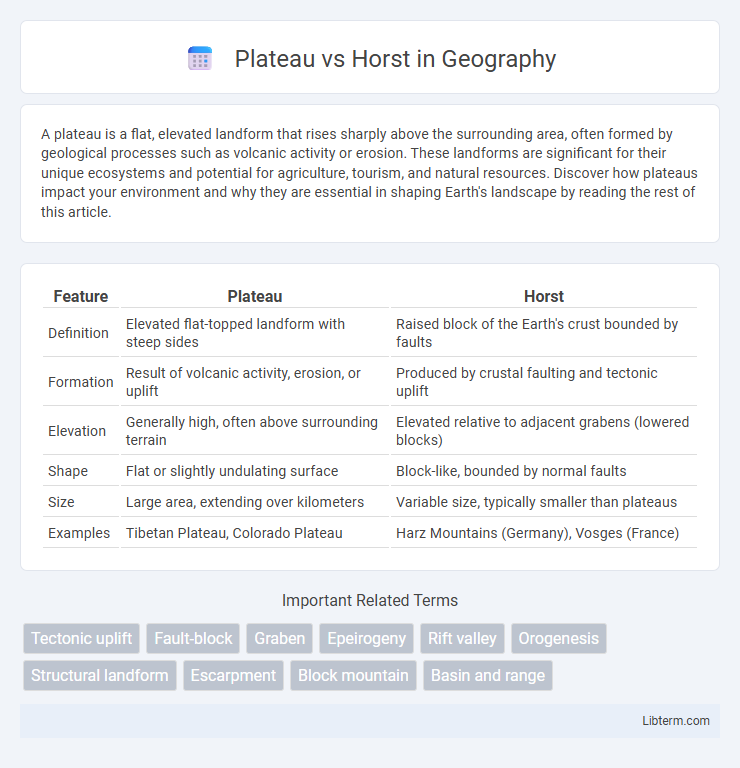A plateau is a flat, elevated landform that rises sharply above the surrounding area, often formed by geological processes such as volcanic activity or erosion. These landforms are significant for their unique ecosystems and potential for agriculture, tourism, and natural resources. Discover how plateaus impact your environment and why they are essential in shaping Earth's landscape by reading the rest of this article.
Table of Comparison
| Feature | Plateau | Horst |
|---|---|---|
| Definition | Elevated flat-topped landform with steep sides | Raised block of the Earth's crust bounded by faults |
| Formation | Result of volcanic activity, erosion, or uplift | Produced by crustal faulting and tectonic uplift |
| Elevation | Generally high, often above surrounding terrain | Elevated relative to adjacent grabens (lowered blocks) |
| Shape | Flat or slightly undulating surface | Block-like, bounded by normal faults |
| Size | Large area, extending over kilometers | Variable size, typically smaller than plateaus |
| Examples | Tibetan Plateau, Colorado Plateau | Harz Mountains (Germany), Vosges (France) |
Introduction to Plateaus and Horsts
Plateaus are elevated flat-topped landforms that rise sharply above the surrounding area, typically formed through volcanic activity or tectonic uplift. Horsts are raised blocks of the Earth's crust bounded by normal faults, often appearing as elongated highlands or ridges. Both features highlight significant tectonic processes shaping the Earth's surface, with plateaus representing broad, uplifted regions and horsts indicating localized crustal block movements.
Geological Formation of Plateaus
Plateaus are elevated flat-topped areas formed primarily through volcanic activity, tectonic uplift, or erosion-resistant rock layers that prevent erosion, distinguishing them from horsts which are raised fault blocks created by tectonic forces. The geological formation of plateaus involves processes such as lava flows causing volcanic plateaus, or regional uplift where large land segments rise due to tectonic compression without significant deformation. Erosional plateaus develop when softer surrounding rocks erode away, leaving harder rock surfaces elevated, highlighting the diverse mechanisms shaping plateau landscapes.
Geological Formation of Horsts
Horsts are elevated blocks of the Earth's crust bounded by parallel faults, formed through extensional tectonic forces causing crustal stretching and faulting. These geological formations typically rise above adjacent down-dropped basins called grabens, creating distinctive topographical highs. Horsts play a crucial role in shaping tectonic landscapes and influence sedimentation patterns in surrounding areas.
Key Differences Between Plateaus and Horsts
Plateaus are extensive flat-topped elevated landforms formed by volcanic activity or sediment accumulation, whereas horsts are raised fault blocks bounded by parallel normal faults, resulting from tectonic forces. Plateaus typically cover large areas with relatively uniform altitude, while horsts are more localized uplifted blocks with steep fault scarps. The key difference lies in their formation; plateaus arise from extensive geological processes like lava flows, whereas horsts develop due to crustal extension and faulting.
Types of Plateaus and Their Features
Plateaus are elevated flat-topped landforms categorized into tectonic, volcanic, dissected, and residual types, each formed by distinct geological processes; tectonic plateaus arise from crustal uplift, volcanic plateaus result from widespread lava flows, dissected plateaus feature extensive erosion creating valleys, while residual plateaus persist after surrounding areas erode. Horsts, in contrast, are uplifted blocks bounded by normal faults, characterized by steep sides and elevated relative to adjacent grabens. Understanding the differences in formation and morphology between plateaus and horsts assists in geological mapping and resource exploration.
Types of Horsts and Their Features
Horsts are elevated blocks of the earth's crust bounded by faults, characterized by types such as simple horsts, which feature symmetrical uplift with parallel fault lines, and compound horsts that consist of multiple uplifted blocks with complex fault patterns. Horsts typically exhibit steep fault scarps, significant tectonic uplift, and are commonly associated with rift valleys or fault-block mountain systems. These structures contrast with plateaus, which are broad, relatively flat elevated landforms formed primarily through volcanic activity or erosion without significant faulting.
Global Examples of Plateaus
Plateaus, elevated flat-topped landforms, are prominent globally with examples like the Tibetan Plateau in Asia, known as the "Roof of the World," and the Colorado Plateau in the United States, characterized by its vast canyons and unique rock formations. The Deccan Plateau in India showcases volcanic origins and extensive lava flows, while the Altiplano in South America stands as the highest plateau outside Tibet, featuring large salt flats and high-altitude lakes. These plateaus differ from horsts, which are raised fault blocks with steep sides formed by tectonic uplift, emphasizing the distinct geological processes shaping Earth's surface.
Global Examples of Horsts
Horsts are raised fault blocks bounded by normal faults, creating elevated regions distinct from adjacent down-dropped grabens. Global examples include the Vosges Mountains in France, the Harz Mountains in Germany, and the Black Forest in southwestern Germany, each showcasing classic horst structures formed by tectonic uplift. These horsts often serve as significant geological landmarks influencing local climate, biodiversity, and human settlement patterns.
Importance of Plateaus and Horsts in Earth’s Topography
Plateaus and horsts play crucial roles in shaping Earth's topography, with plateaus providing elevated flatlands that influence climate patterns and support diverse ecosystems, while horsts form significant geological structures that reveal the processes of crustal deformation and faulting. Plateaus often serve as important locations for human settlement, agriculture, and natural resources, contributing to economic development. Horsts, typically bounded by faults, are key indicators of tectonic activity and help geologists understand the Earth's structural evolution and seismic risks.
Conclusion: Plateau vs Horst Comparison
A plateau is an elevated flat landform with broad, level surfaces resulting from uplift or erosion, while a horst is an uplifted block bounded by faults, characterized by steep sides and a narrower top. Plateaus typically cover extensive areas and have gradual slopes, whereas horsts are more localized and exhibit pronounced fault-bound edges. Understanding these distinctions aids in geological mapping and resource exploration across tectonically active regions.
Plateau Infographic

 libterm.com
libterm.com